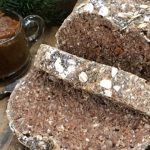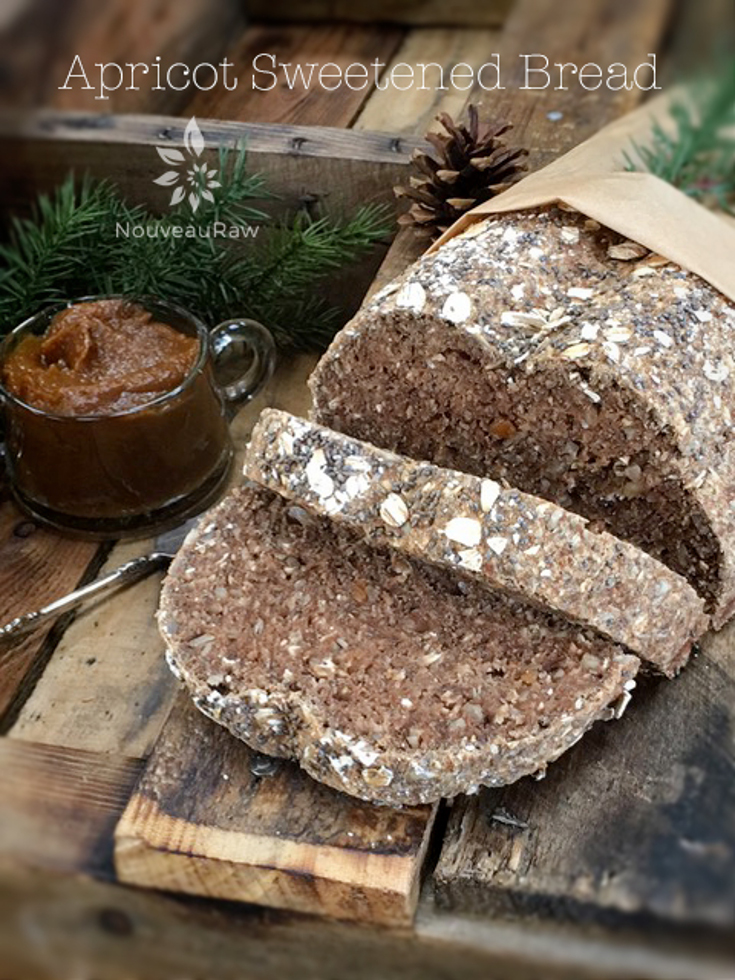
|
Recipe by:Amie Sue
|
Almond Apricot Bread
Prep:1hourTotal:18hoursServes:8
Ingredients

- 2cupsrolled oats(gluten-free, soaked and dehydrated)
- 1cupsunflower seeds(raw, soaked and dehydrated)
- 1/2cupchia seeds
- 3Tbsppsyllium husk powder
- 1tsphimalayan pink salt
- 1tspCeylon cinnamon(ground)
- 1/2tspAllspice
- 3Tbspmaple syrup
- 2bananas(ripe)
- 1.75cupswater
- 1/2tspliquid stevia
- 1cupdried apricots(diced)
- 4cupsalmond pulpmoist, packed cups)
Apricot Spread
- 1cupdried apricots(diced, soaked in hot water 15 min)
- 2Tbspwater
| Directions |
|

Bread
- In the food processor, fitted with the “S” blade, pulse together the oats, sunflower seeds, chia seeds, psyllium, salt, cinnamon and allspice. Place in a bowl.
- In the same food processor bowl, combine the maple syrup, bananas, water, stevia and apricots. Process till mixed but not to long that you break down the apricots too much.
- Add to the dry ingredients, along with the almond pulp. With your hands, mixed everything together very well. If the batter feels to dry, add a little water 1 Tbsp at a time.
- Place the batter on a non-stick surface and shape into a loaf. Sprinkle crushed rolled oats and chia seeds on top. Transfer to the mesh sheet that comes with the dehydrator.
- Dehydrate at 145 degrees for 1 hour. This will create a crust on the outside.
- Remove from the dehydrator, place the loaf on a cutting board and slice pieces to a desired thickness. Don’t slice the bread on the mesh, you don’t want to risk cutting it. I did mine at about 1 inch. When slicing the bread at this stage, be sure to use a serrated knife (blade has small teeth, this helps to cut through nice and smooth) Also, see-saw back and forth with downward pressure as your cut the slices. This will prevent the dough from squashing down. Return the bread to the mesh sheet laying the pieces flat.
- Decrease the temperature to 115 degrees (F) and continue to dehydrate for approx. 16 hours. As an indicator if it is dry enough, touch the center of the bread slices. You don’t want it to be doughy but you also don’t want the bread to dry out too much.
- Shelf life and storage: My personal recommendation would be to store this bread in an air-tight container, in the fridge, for 3-5 days. The more moisture that is left in your bread, the shorter the shelf life. Therefore, shelf life will vary with your drying technique. Whenever I make this bread, it never lasts very long enough to spoil. Keep in mind, the whole purpose of eating a raw diet is to eat foods at their peek of freshness, so don’t expect this bread to have a long shelf life.
Apricot spread
- Drain the apricots from the soak water, don’t discard the liquid, keep it for step 2.
- Add to the food processor, along with 2 Tbsp soak water and process till creamy. Add more water if needed.
- This spread should keep for 5-7 days in the fridge.
|
Ingredients

Apricot Spread
|

Bread
Apricot spread
|
|
Directions
 Bread
Apricot spread
|


